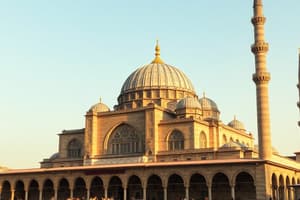Podcast
Questions and Answers
Who was the founder of the Ottoman Empire?
Who was the founder of the Ottoman Empire?
- Suleiman I
- Osman (correct)
- Hurren Sultan
- Mehmet II
Which military unit was central to the Ottoman Empire's military power?
Which military unit was central to the Ottoman Empire's military power?
- Mameluks
- Janissaries (correct)
- Sultan's Guard
- Spahis
What was the primary purpose of the Millet System in the Ottoman Empire?
What was the primary purpose of the Millet System in the Ottoman Empire?
- To conduct royal inquisitions
- To conquer new territories
- To oversee military operations
- To manage religious and ethnic groups (correct)
What significant event marked the end of the Byzantine Empire?
What significant event marked the end of the Byzantine Empire?
Which of the following was an initiative attributed to Hurren Sultan?
Which of the following was an initiative attributed to Hurren Sultan?
What characterized the technological style of the Safavid Empire compared to the Ottoman Empire?
What characterized the technological style of the Safavid Empire compared to the Ottoman Empire?
Which of the following was a major event during Suleiman I's reign?
Which of the following was a major event during Suleiman I's reign?
What was one consequence of the Ottoman Empire's attempts to conquer Vienna?
What was one consequence of the Ottoman Empire's attempts to conquer Vienna?
During which era did women begin to take significant power in the Ottoman Empire?
During which era did women begin to take significant power in the Ottoman Empire?
Which religious conflict marked the rivalry between the Ottoman and Safavid Empires?
Which religious conflict marked the rivalry between the Ottoman and Safavid Empires?
Flashcards
Ottoman Empire Origins
Ottoman Empire Origins
Founded in 1299 in Turkey, initially led by pastoral nomadic rulers who converted to Islam and defeated the Byzantine Empire.
Janissaries
Janissaries
Elite infantry slave soldiers in the Ottoman army, skilled in warfare and holding high positions.
Mehmet II
Mehmet II
Ottoman sultan who conquered Constantinople in 1453, ending the Byzantine Empire.
Suleiman I the Magnificent
Suleiman I the Magnificent
Signup and view all the flashcards
Millet System
Millet System
Signup and view all the flashcards
Sultanate of Women
Sultanate of Women
Signup and view all the flashcards
Safavid Empire
Safavid Empire
Signup and view all the flashcards
Battle of Mohacs
Battle of Mohacs
Signup and view all the flashcards
Ottoman Decline
Ottoman Decline
Signup and view all the flashcards
Taqi al-Din
Taqi al-Din
Signup and view all the flashcards
Study Notes
Origins and Rise of the Ottoman Empire
- Founded in 1299 in Turkey
- Initially pastoral nomadic, led by khans (fictive kinship)
- Converted to Islam, defeated Byzantines, leading to modern Turkey's formation
- Adopted non-nomadic traditions
- Expanded north into the Balkans, notably through campaigns against Bulgaria
- Osman was the founder
- Janissaries (elite infantry) were slave soldiers, highly trained and mobile, using primitive muskets, and reaching high positions (generals).
- Conquest of Constantinople in 1453 by Mehmet II, using siege warfare and giant cannons
- Suleiman I the Magnificent led to the Empire's apex, expanding into North Africa and Mesopotamia, and engaging with the powerful Habsburg Dynasty in Europe (Battle of Mohacs)
- Repeated failed attempts to conquer Vienna
Administration, Religion, Law, and Culture
- Millet System: a religious/ethnic administrative system
- Ottoman Empire had different leaders for different religions (e.g., Rabbi for Jews) and tolerated various religions within the empire
- Suleiman I the Magnificent enacted legislation that protected Jews within newly conquered areas.
- Religious minorities faced persecution and attacks (pogroms, blood libels) at various instances throughout history
- Architectural achievements include the Blue Mosque, a prominent example of Ottoman architectural style.
- Decline in science and technology was noticeable by the 1800s.
The Sultanate of Women
- Hurrem Sultan (Roxelana), wife of Suleiman I, known for social reforms (hospitals, soup kitchens)
- Women eventually significantly influenced Ottoman politics (late 1500s/early 1600s)
The Safavid Empire
- Major rival to the Ottoman Empire, differing religiously (Sunni vs. Shia)
- Used gunpowder technology to compete with the Ottomans.
- Shah Abbas led the Safavids.
- Architectural style of the Safavid Empire was inspired by Chinese/East Asian designs (harmony, blending) - distinct from the grand, heavier Ottoman style.
Studying That Suits You
Use AI to generate personalized quizzes and flashcards to suit your learning preferences.
Description
Explore the fascinating history of the Ottoman Empire, from its founding in 1299 to its peak under Suleiman I. This quiz delves into the empire's significant events, including the conquest of Constantinople and its unique administrative systems. Test your knowledge on the key figures and expansions that shaped modern Turkey and its surroundings.




